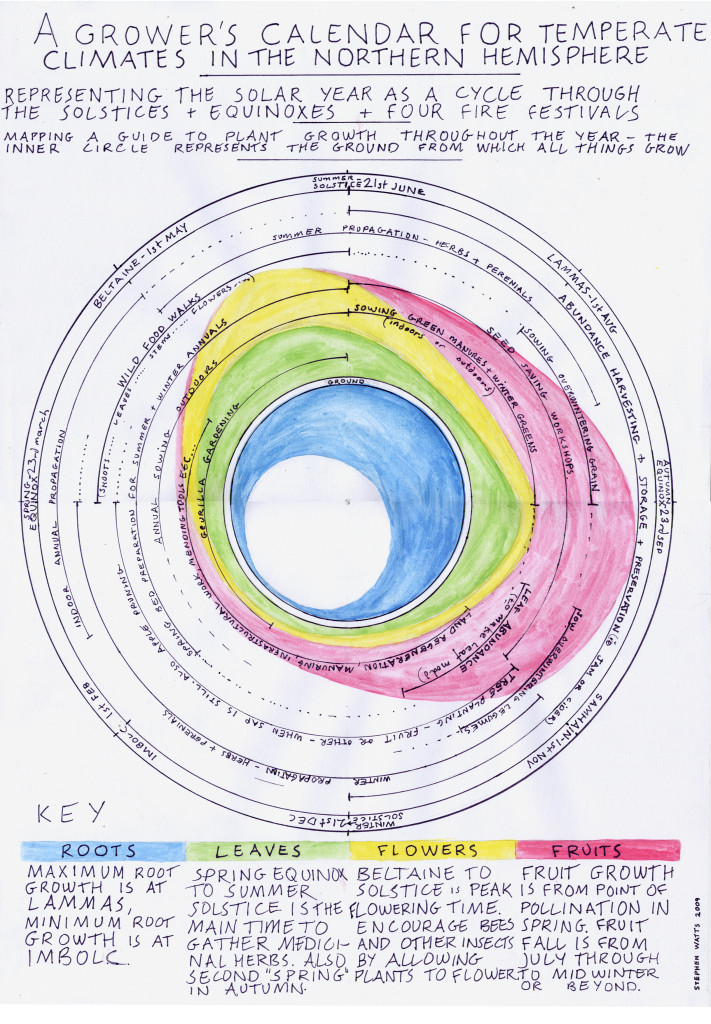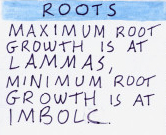MERGING SOLAR YEAR WITH BASIC STAGES OF PLANT GROWTH
Root growth is represented on the inner circle in blue, growing inwards throughout summer, away from the white circle, which represents the Ground. The inner circle is the earth, which the roots grow into and explore.
Plant growth is at its maximum about 6 weeks after the earth has passed summer solstice, round about Lammas time, because the soil temperature warms up and maintains its heat throughout the summer. Root Growth directly relates to soil temperature.
Annual root vegetables grown into the winter (parsnips, carrots, beetroot, etc) will have to be eaten before the spring unless you want to collect seed. Some may need lifting before the winter, but most will store in the ground.
Perennial root vegetables are mostly eaten throughout the winter (Jerusalem artichokes, skirett, scorzonera) so as to give the roots full potential throughout the growing season to develop to full size.
Root layering and suckering happens throughout the summer on soft fruit plants and herbs and perennials – propagate by digging up roots with shoots and pot on into suitable sized pot with potting compost.
Leaf growth is represented with the colour green, surrounding the inner circle and growing outwards. From the ground emerges the shoot.
Wild greens can be picked all year round, but they are best picked in spring. From Spring equinox to about Midsummer wild greens really come into their own – as the temperature starts to warm up, any perennial roots in the ground will burst into fresh green growth. By the beginning of June the plants will go to seed (unless interrupted by chopping them down,) at which point the leaves will loose their vitality, and will become more fibrous and chewy.
Most plants aim to produce seed – after perennial greens have gone to seed during the summer, some of them will put on a second leaf growth in the autumn, so as to store up energy for next year. The plants know that they do not have enough light or warmth to produce any more seed and so concentrate on leaf growth. This I call the second spring, in which you can start to pick wild greens again – nettles, cow parsley, sweet cicely, fennel, etc
Aim to get a continuous supply of fresh greens all year round. If you are by a spring, get watercress growing in it and you will be able to pick this most of the year. Land cress, mustard, rocket and lambs lettuce are just some of the annual greens which the slugs don’t eat and will survive the winter.
Trees drop their leaves around about Samhain – some before, some after. The year is continuous – leaf fall symbolises the end of one growing year and the beginning of the next. Begin your growing year by giving something back to the earth. Sweep up fallen leaves to make into leaf mould. The more leaves you gather in any one pile the hotter it will compost. Keep this compost separate from your other compost. Use one year old or older leaf mould for potting compost. As well as a general soil improver.
Flower growth is represented with the color yellow – plants will flower when leaf growth has been established.
There are plants which flower all year round like Gorse, and some which only flower in winter, like Winter Jasmine, but the most abundant time for flowers would have to be May and June when many of the trees go into there flowering phases. Hawthorn is known as the “May Flower”. And Elderflowers I always associate with midsummer. Also many of the over-wintering annuals and perennials will all go to seed – all the brassicas, all the wild greens, all the annual root crops. Hence May and early June are known traditionally as the hungry gap. There are however many flowers to eat- you can eat the flowers of practically all the common food plants as well as many not so well known ones like compannular flowers, columbine flowers, and the delicious day lily flowers.
Without the flowers there is no fruit. And without bees to pollinate the flowers there is no fruit. Make sure your garden has plenty of flowers for the bees – even just leaving a few dandelions and buttercups to grow will help. Flowers give off ultra violet light. Eating flowers can be very healing on a deep energetic level (i.e. beyond physical level). Make your own flower remedies by picking unplanted flowers and placing them in pure spring water for a day or so then drink the water, or use it in baths etc.
Fruit and seed Growth and Storage are represented by the color red. The pollinated flowers become the fruits and the seeds.
The most common early fruit is strawberries, which start to crop just after midsummer. The abundance has returned and from that point onwards you can be eating your own fresh fruit everyday. The big challenge with fruit is trying to avoid gluts of it and getting it to store through the hungry gap.
I have been picking apples off the trees in January and finding ok apples on the ground in April. Once the ground temperature has reached about freezing any fruit on the ground will tend to keep ok, until the wildlife starts eating at it!
Sowing over-wintering legumes will give you an early crop in around may/June (earlier down south). Broad beans, and peas will be the only ones able to tolerate the frosts. Sowing over-wintering grain around about Lammas time gives one a chance to look ahead to next year. Rye, oats, wheat and barley are the grains, which can tolerate the frosts.
Allow some plants of each vegetable to go to seed each year. When the seed heads are dry, pull out the plant and place on a dry cloth or bed sheet and jump up and down on them! Or rub them with your hands or bash the plants with a stick – each plant requires a slightly different method. See what works for you. Try not to get soil mixed up with the seeds. Store the seeds in paper bags and don’t forget to label them with the year.
Stephen Watts
2009





